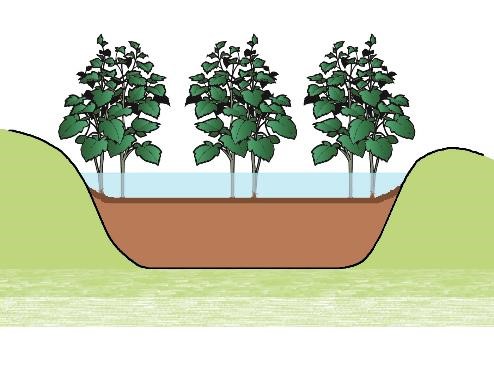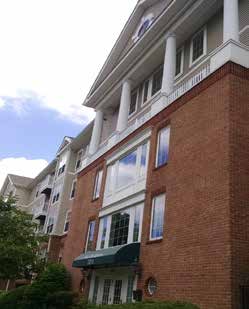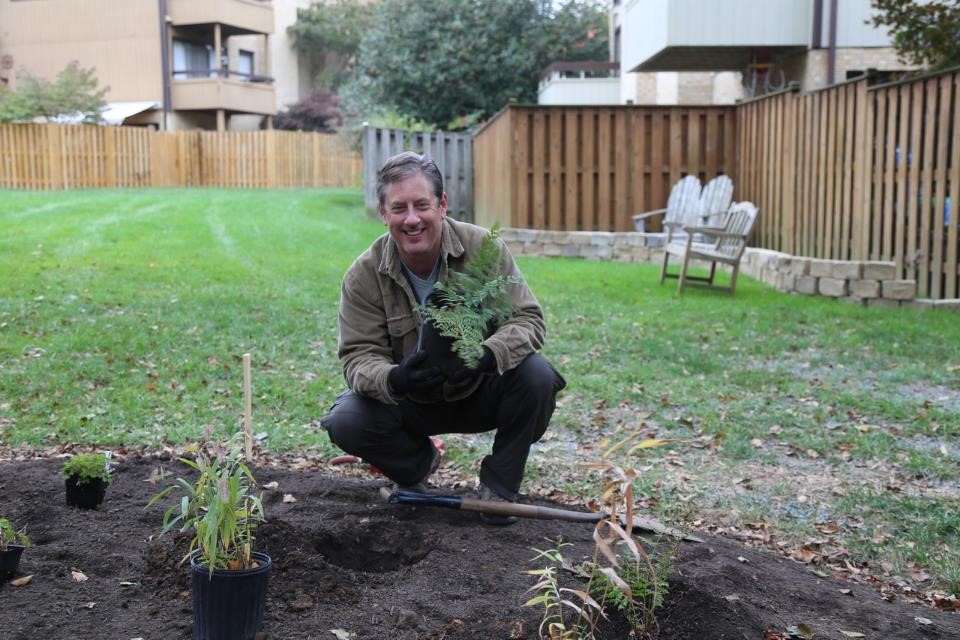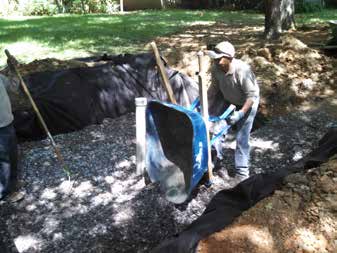You’re going to have to beat us away from applying again in the future. This is an awesome program and it’s exciting that it’s now open to places of worship and individual homeowners. -- Renee Grebe
In spring 2015, Grebe jumped on the chance to get her community involved in the Conservation Assistance Program. Loft Ridge Civic Association, off of Franconia Road in Alexandria, began with a rain garden downhill of a line of townhomes. Grebe and fellow residents had been adopting areas throughout the community for pollinator gardens and native plants for several years. When the opportunity came to receive matching funding to install a rain garden, Grebe led the way.
A rain garden is typically dug down 2-3 feet, with a ponding area of 6-12 inches on top and a highly porous, rich soil media used to capture and absorb runoff. Rain gardens should be well-drained and they rely on having sufficient infiltration at the bottom of the excavated area to be able to pass water through to the existing soil, or use an underdrain to achieve the same effect. Loft Ridge’s soil type varies widely in infiltration, and the rain garden project was contingent on the results of a test. Luckily, the site drained quickly - on average, eight inches per hour.

Grebe was thrilled. They worked closely with their contractor and Northern Virginia Soil and Water Conservation District staff to get the project installed on time and even under budget. The result is a fantastic amenity for the community and a real water quality benefit for Cameron Run downstream.
In 2016, Grebe came back with a second project. The community had identified a seep, or a natural spring, coming from a hillslope on their property. The wetness made it difficult for grass to grow, and they were convinced that there was a better option. They chose to install water-tolerant native plants as conservation landscaping to revegetate and reinvigorate the area, as well as to reduce the amount of mowed turf. Grebe used a plastic tarp to kill off the grass, then brought mulch and plugs and pots to stabilize the soil on the slope, keep down the weeds, and help the new plants grow. With the help of about a dozen volunteers, they completed the planting in early October 2016. The area is now covered in native flowering perennials, grasses and sedges.
Overcoming Challenges at Loft Ridge
In the Loft Ridge community, a major challenge is keeping the deer away. They have installed tree tubes and deer fencing to deter them and have chosen species that are more deer resistant. “Nothing is totally deer-proof,” says Grebe, “But we are staying on top of it.”
The Loft Ridge Board of Directors has been very supportive of the efforts to beautify the common spaces and provide habitat for birds and pollinators. They are appreciative of the benefit that these projects bring to the community.
Loft Ridge has also been proactive in finding contractors and plant suppliers who are willing to work with their budget. Grebe and other community members dove into the project, learning how to conduct an infiltration test, set plant spacing and recruiting volunteers within the community and among local Master Naturalist groups. Grebe says, “This program is a great resource for communities looking to make a difference.”
Energy Upgrades at Pavilion Condominium

At Pavilion Condominium Association next to the West Falls Church metro station, residents value transit and having a small carbon footprint. So when resident Bob Opfer heard about the Energy Conservation Assistance available, he reached out to the Soil and Water Conservation District to learn more.
Windows and lighting in the common areas were high on Pavilion Condominium’s priorities. Both projects were expensive, and NVSWCD staff encouraged the community to request several bids. In spring 2016, Pavilion moved forward to switch the large, old, leaky windows in the shared areas of their buildings for updated low-E replacements. Residents are very happy with the results, noticing the difference during community meetings - as well as in their energy bills. Pavilion plans to apply again to make the switch from the old outdoor lighting (halogen??) to LED lights that will save them money and energy.
“This was a no-brainer” Opfer said. “When I brought this to the board, they were very supportive. There was a large one-time investment, but having the Conservation Assistance Program support helped make the case that this was a worthwhile and urgent project.”
Controlling Heavy Runoff at Chesterfield Mews

At Chesterfield Mews, an active grounds committee and board working together have helped open the way for landscaping projects that resolve existing issues and provide environmental benefits. In one of the community’s common areas, shaded conditions and heavy runoff made it difficult to establish grass and prevent erosion upstream of more natural areas.
The community reached out to the Northern Virginia Soil and Water Conservation District for technical advice shortly before the Conservation Assistance Program began accepting applications in spring 2015.
Staff recommended an infiltration trench to capture and absorb runoff, while still keeping a trafficked area with grass cover. Conservation landscaping was added around mature river birches to reduce the turf area and add native vegetation.
An infiltration trench, like a large dry well, is filled with gravel. Like a rain garden, it depends on having sufficient percolation at the bottom of the trench so the soil below can absorb the runoff. The Chesterfield Mews trench was approximately 10’x10’ at the surface and 3’ deep. Topsoil and sod is typically added over filter fabric, although stone can also be used as a top layer.

The community received multiple bids and went with a contractor they had worked with previously. On advice from NVSWCD, strategically placed catch basins (grated inlets attached to underground pipes) captured runoff close to the downspout sources and carried the water into the trench, preventing erosion that could have clogged it with sediment. Shade-tolerant sod was watered throughout the first hot summer to ensure that grass would be established.
“In some communities, more participation in these committees can make coming to consensus more difficult. But at Chesterfield Mews, we are lucky to be able to work together, compromise and keep the common goal in mind even if we sometimes disagree on some of the details. We can’t always make everyone happy, but by addressing one problem at a time, we have been able to make real progress,” said John Whitlock, Chesterfield Mews’ president.
The community was very happy with the final result. Whitlock said, “It had been a problem for a long time, and we were pleased that we could find a solution that works for our community and provides a water quality benefit.”
Conservation Assistance Program: How To Apply
NVSWCD is currently accepting site visit requests.
To learn more, click here
Funding for the Conservation Assistance Program is generously provided by the Fairfax County Environmental Improvement Program and the Virginia Department of Environmental Quality.

